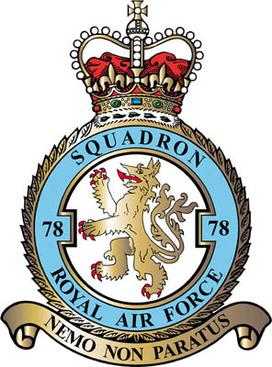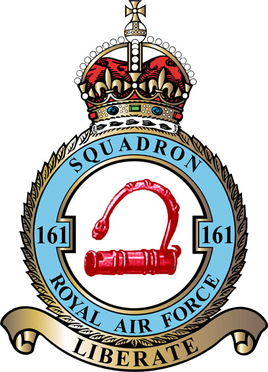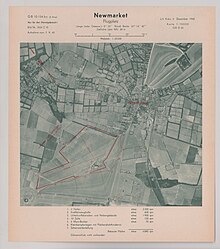
Royal Air Force Leeming or more simply RAF Leeming is a Royal Air Force station located near Leeming, North Yorkshire, England. It was opened in 1940 and was jointly used by the RAF and the Royal Canadian Air Force (RCAF). Between 1950 and 1991, it operated mostly as a training base with Quick Reaction Force (QRF) Panavia Tornado F3 fighters based there in the latter stages of the Cold War and into the early 21st century. Since 2006, it has become the home of the deployable RAF communications cadre and the home of No. 135 Expeditionary Air Wing.

Joint Helicopter Command Flying Station Aldergrove, also known as simply JHC FS Aldergrove, is a British military base located 4.4 miles (7.1 km) south of Antrim, Northern Ireland and 18 miles (29 km) northwest of Belfast, and adjoins Belfast International Airport. It is sometimes referred to simply as Aldergrove which is the name of a nearby hamlet.

Royal Air Force Tangmere or more simply RAF Tangmere is a former Royal Air Force station located in Tangmere, England, famous for its role in the Battle of Britain.

Royal Air Force Chivenor, or more simply RAF Chivenor, was a Royal Air Force station located on the northern shore of the River Taw estuary, on the north coast of Devon, England. The nearest towns are Barnstaple and Braunton.

Royal Air Force Leconfield or more simply RAF Leconfield is a former Royal Air Force station located in Leconfield, East Riding of Yorkshire, England.

No. 78 Squadron of the Royal Air Force, is the squadron number plate of RAF (Unit) Swanwick based at London Area Control Centre, Swanwick, Hampshire. The squadron was allocated the role in early 2021.

Number 13 Squadron, also written as XIII Squadron, is a squadron of the Royal Air Force which operate the General Atomics MQ-9A Reaper unmanned aerial vehicle from RAF Waddington since reforming on 26 October 2012. The unit first formed as part of the Royal Flying Corps on 10 January 1915 and went on to fly the Martinsyde G.100, the Royal Aircraft Factory F.E.2, the SPAD VII and SPAD XIII, the Sopwith Dolphin during the First World War. In the Second World War it started out operating the Westland Lysander for army cooperation. From late 1942 it used Blenheims in North Africa but in 1943 squadron converted to Ventura for coastal patrols and convoy escort duties. Post war it operated Mosquito before transitioning to the new jet aircraft Gloster Meteor and English Electric Canberra for photoreconnaissance. From 1 January 1990, it operated the Panavia Tornado, initially the GR1A at RAF Honington and later the GR4/4A at RAF Marham where it temporarily disbanded on 13 May 2011.

RAF Tempsford is a former Royal Air Force station located 2.3 miles (3.7 km) north east of Sandy, Bedfordshire, England and 4.4 miles (7.1 km) south of St. Neots, Cambridgeshire, England.

Royal Air Force Barford St John or more simply RAF Barford St John is a Royal Air Force station just north of the village of Barford St. John, Oxfordshire, England. It is now a non-flying facility, operated by the United States Air Force as a communications centre with many large communications aerials, and is a satellite of RAF Croughton.

Llanbedr Airport, formerly RAE Llanbedr, is an operational general aviation airport located in the Snowdonia National Park near the village of Llanbedr, Gwynedd, northwest Wales.

No. 161 Squadron was a highly secretive unit of the Royal Air Force, performing missions as part of the Royal Air Force Special Duties Service. It was tasked with missions of the Special Operations Executive (SOE) and the Secret Intelligence Service (SIS) during the Second World War. Their primary role was to drop and collect secret agents and equipment into and from Nazi-occupied Europe. The squadron had a secondary role in acting as the King's Flight.

Royal Air Force Horsham St Faith or more simply RAF Horsham St Faith is a former Royal Air Force station near Norwich, Norfolk, England which was operational from 1939 to 1963. It was then developed as Norwich International Airport.

Royal Air Force Fairwood Common, or more simply RAF Fairwood Common, is a former Royal Air Force Sector Station located on Fairwood Common, on the Gower Peninsula, to the west of Swansea. It is now the location of Swansea Airport.

Royal Air Force Hawkinge or more simply RAF Hawkinge is a former Royal Air Force station located 13.23 miles (21.29 km) east of Ashford, 2.2 miles (3.5 km) north of Folkestone, Kent and 7.1 miles (11.4 km) west of Dover, Kent, England. The airfield was used by both the Royal Flying Corps and the Royal Air Force during its lifetime and was involved during the Battle of Britain, as well as other important aerial battles during the Second World War and the early stages of aerial usage in war in the First World War.

Hugh Verity, was a Royal Air Force fighter pilot and later a "special duties" squadron pilot working with the Special Operations Executive (SOE) during World War II. He landed many times at clandestine airfields in occupied France to insert and extract SOE agents. He was decorated for gallantry five times.

Royal Air Force Haverfordwest or more commonly RAF Haverfordwest, is a former Royal Air Force station located 2.1 miles (3.4 km) north of Haverfordwest, Pembrokeshire and 11 miles (18 km) south of Fishguard, Pembrokeshire, Wales.

Royal Air Force Talbenny, or more simply RAF Talbenny, is a former Royal Air Force station located 5.6 miles (9.0 km) north west of Milford Haven, Pembrokeshire and 7.9 miles (12.7 km) south west of Haverfordwest, Pembrokeshire, Wales.
Royal Air Force Clifton, or more simply RAF Clifton, is a former Royal Air Force station located 1.5 miles (2.4 km) north west of York city centre and 2.6 miles (4.2 km) south west of Haxby, North Yorkshire, England.

No. 16 Group RAF was a group of the Royal Air Force. It existed over two periods in two different roles. No. 16 Group was initially a training group, from 1918 to 1920, that had been transferred from the Royal Flying Corps. It reformed as a reconnaissance group under RAF Coastal Command, in 1936.



















